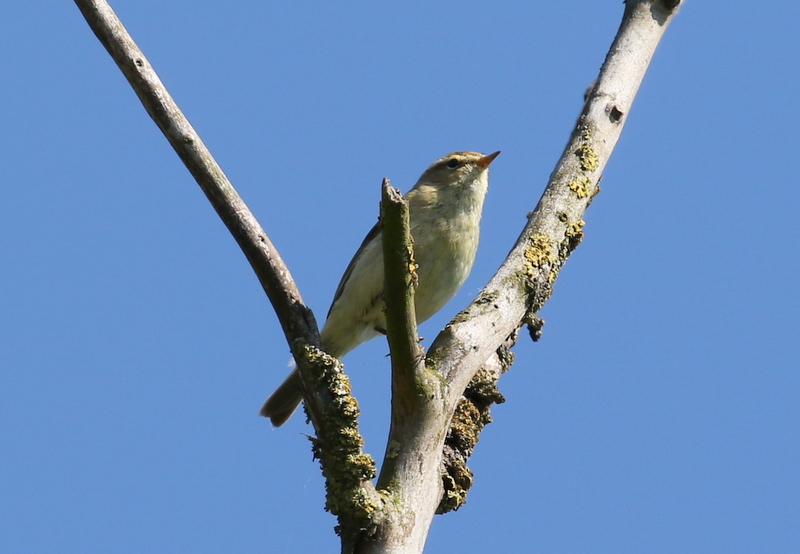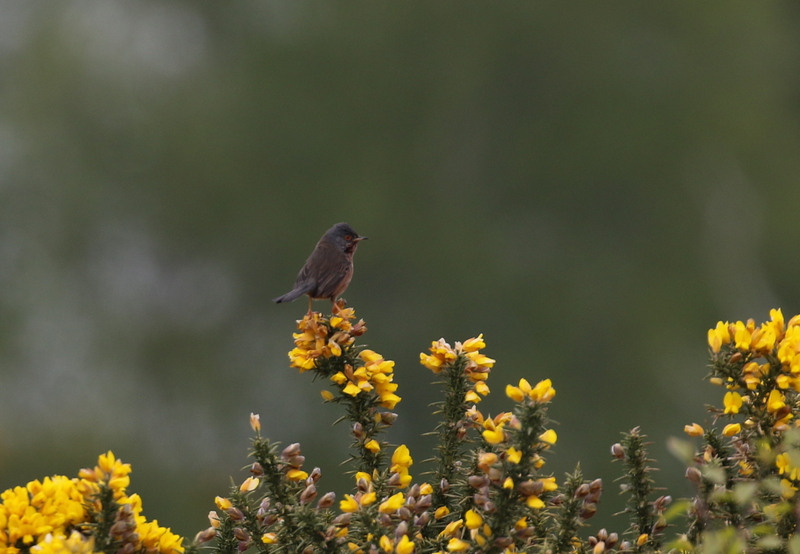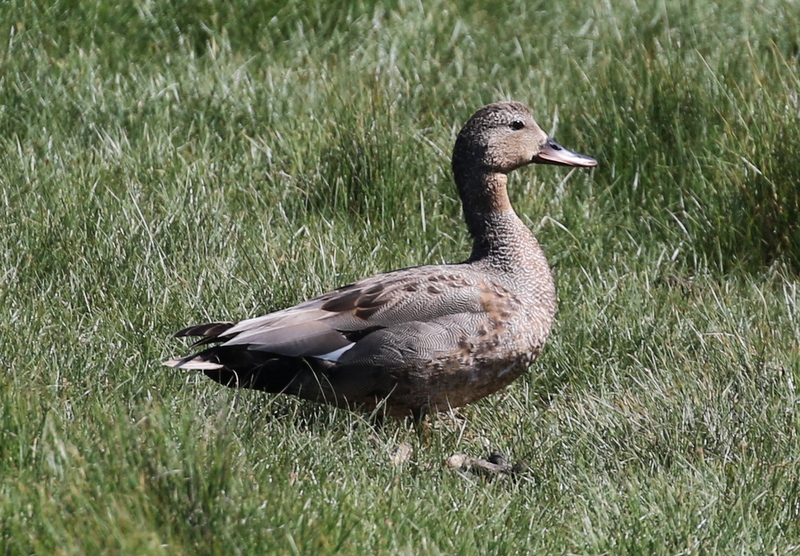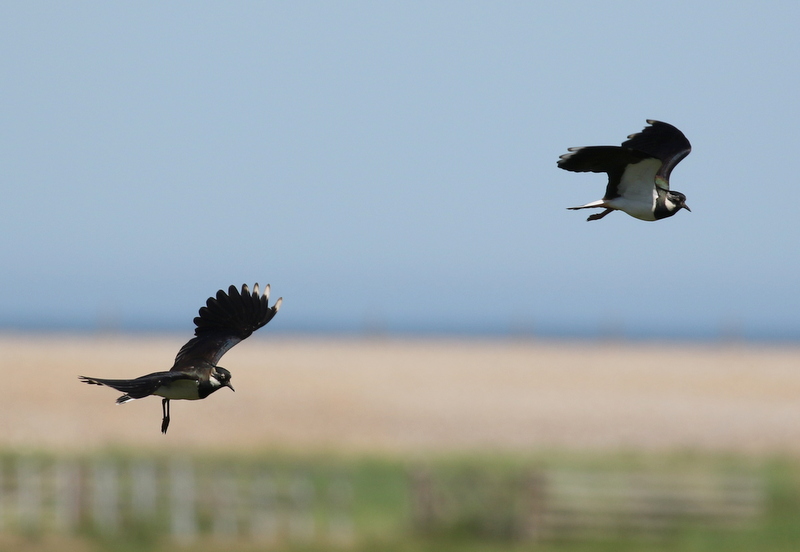A Private Tour today in North Norfolk. It was hot and sunny, with the mercury topping out at an unseasonably warm 26.5C on the coast (and so probably hotter still inland!). A band of thundery rain passed through quickly around the middle of the day which meant it was a bit fresher in the afternoon, with a strengthening southerly wind.
At our first stop of the day, we went looking for Nightingales. We parked the car at the top of a lane by a copse of willows and listened. A Blackcap was singing in the trees but there was no sound from the Nightingale here this morning. Perhaps not a surprise, as the day was already heating up!
We walked further up the lane, listening to all the warblers singing. There were several Chiffchaffs, chiffing and chaffing, and we heard the sweet descending song of a Willow Warbler which was perched high in the top of a dead tree – two rather similar looking birds but with very different songs. From the other side of the hedge, a Sedge Warbler was buzzing and scratching away frenetically. A Cetti’s Warbler shouted at us unseen, from deep in the bushes, as we passed. A Common Whitethroat appeared in the top of the hedge next to us.
 Chiffchaff – there were several singing in the hedges along the lane
Chiffchaff – there were several singing in the hedges along the lane
Even as we approached the next block of trees, we could a couple of melodic phrases of a Nightingale singing, carried to us above the rustling of the leaves in the breeze. When we got there, we stopped to listen. There were several Blackcaps singing, a beautiful melodic song in its own right. Then the Nightingale started up again, rich and flutey, very varied little bursts interspersed with pauses.
The Nightingale was deep in the wood at first but after a minute or two it went quiet. When it started singing again, it was much closer to us and we knew the song was coming from its favourite tangle of brambles and dead branches. We walked across to where we could view the bushes, but it was not perched out in the sun today and still seemed to prefer to keep in cover. We got a quick glimpse as it flicked up into the brambles from close to the ground at one point, a flash of rusty orange tail as it disappeared into the green leaves. Then it went quiet again.
From where we were standing, we could hear a Cuckoo singing. We walked a little further up the lane and looked out across the wet meadow towards the willows. There was no sign of it at first, but looking across every time it sang, the Cuckoo suddenly appeared in the trees. We managed to get it in the scope, and everyone got a quick look at it, before it flew back into the willows out of view. We could still hear it but couldn’t see it any more.
Walking back up the lane, we stopped to listen to the Nightingale again. It was singing once more, but it was still keeping deep in the thicket. Nightingales are not the most colourful of birds – it is more about the song, so it was great just to stand and listen to it singing. When it went quiet again, we decided to move on.
We headed up to one of the heaths next. It was getting hot now, but there was a bit of a breeze up on the ridge which helped to keep the humidity down up here. The warblers were singing up here too, mainly Blackcaps and Willow Warblers in the trees and Common Whitethroats out on the heath. We came across several little family parties of Linnets in the gorse, which flew off calling as we passed.
At the first spot where we hoped we might find a Dartford Warbler, it seemed rather quiet at first. However, as we started to walk slowly round the area, we suddenly heard a male Dartford Warbler singing further along. We headed over there but as we came round a corner and out into the open we surprised it on the top of a gorse bush right by the path. We got a quick flight view as it zipped across in front of us, but it flew into a large area of deeper bushes.
We stood for a few seconds and listened, and it wasn’t long before the Dartford Warbler started singing again, this time launching itself into the air in a brief song flight. We could see it had gone much further back across the gorse. As we walked round to the other side, the Dartford Warbler flew up into the top of another large gorse bush and perched there in full view singing for a few seconds, giving us a much better if brief look at it. Unfortunately not everyone could get onto it in time and then it dropped back into the gorse again.
 Dartford Warbler – this one taken recently on the Heath
Dartford Warbler – this one taken recently on the Heath
It was rather frustrating over the next few minutes. The Dartford Warbler kept calling and singing on and off, but it kept tucked down in a large clump of gorse where we couldn’t see it. The forecast had suggested there was a risk of some thundery showers around the middle of the day and at this point we looked over towards the SW and could see a bank of cloud starting to build. We wanted to have a look round the Heath, so we moved quickly on, just in case.
A Yellowhammer was singing from somewhere in the trees as we passed, and another perched up nicely on the top of a post briefly, a smart yellow-headed male. When we got down to the old railway cutting, we could hear another Dartford Warbler singing. We looked across to see a male on the top of the heather on the other side. It spend a couple of minutes hopping around, disappearing at times, but then coming back up. When it flew up and landed on the wire fence beyond, it was followed by a second Dartford Warbler, male & female. The female was carrying food in her bill. Then they zipped off back further and disappeared into the gorse beyond, presumably off to feed a hungry brood somewhere.
The approaching cloud was getting steadily darker now, and we could hear the first rumbles of thunder. We knew we only had a very limited time before it was likely to rain. We walked quickly round to see if we could get a better look at the Dartford Warblers, but it was increasingly clear that rain was imminently coming our way, so we had to give up and head straight back to car. It was already spitting but we arrived just in the nick of time, as it started to rain properly.
It was a shame we did not have more time to explore the Heath properly today, but at least we had seen the Dartford Warblers. We drove down to the coast in the rain, but it was already starting to ease when we got down to the car park at Cley Marshes. We headed into the visitor centre to use the facilities and when we came out again the rain had already stopped. Even better, the sky seemed to be starting to brighten again beyond. We decided to have an early lunch outside on the picnic benches and it was sunny again by the time we finished.
After lunch, we headed out to explore the reserve and walked along the boardwalk to the main hides. There were lots of House Sparrows chirping away in the bushes by the drainage channel and several House Martins hawking for insects low over the grazing marshes. A Little Egret flew overhead, heading west presumably to feed and was passed by another heading back in towards the nesting colony.
At Dauke’s Hide, there were lots of Shelduck, both adults and a large gathering of small juveniles. At first, they were swimming and feeding feverishly, heads under the water, while a pair of adults stood preening on an island a short distance away. When the juveniles went over to join the adults on the island, we could count there were a whopping 18 of them in total.
 Shelduck – this pair were looking after 18 small shelducklings
Shelduck – this pair were looking after 18 small shelducklings
However, on closer inspection it was clear the juvenile Shelducks were of two different ages, some slightly smaller and darker and others a little bigger and more faded. They were presumably two different broods which had been creched together, with one unfortunate set of parents inheriting childcare duties for the whole lot!
There are always lots of Avocets on the scrapes at this time of the year. There were several still on nests, but there was one juvenile out on Simmond’s Scrape, a little bundle of fluff with long legs and uptilted bill.
The young Avocets are very vulnerable to predation and invariably suffer high losses – this one was allowed to wander off on its own with what was presumably one of its parents standing and preening on one of the islands some distance away. All the adults would periodically take off calling noisily and attempt to chase off whichever potential predator was approaching, a crow, a large gull or a raptor passing overhead. Meanwhile, the youngsters are left behind, even more vulnerable – the Avocet approach to childcare!
 Avocets – dropping back down after attempting to chase off a Marsh Harrier
Avocets – dropping back down after attempting to chase off a Marsh Harrier
There was a nice selection of other waders on Simmond’s Scrape today. A Little Ringed Plover was creeping around on the edge of one of the nearer islands, and through the scope we could see its bright golden yellow eyering. Two Common Ringed Plovers were out on the mud further back, their slightly small size and dark appearance suggesting they were most likely of the tundrae race, far northerly breeders passing through.
There were several Redshank out on the mud too but one bird near them was similar but subtly different. Slightly smaller, shorter billed, with less bright legs, it was a female Ruff, in summer plumage, marked with black on its upperparts. A smart Lapwing on the bank in front of the hide looked especially striking, its glossy iridescent green upperparts shining bronze and purple in the sunshine.
 Lapwing – irridescent in the sunshine in front of Dauke’s Hide
Lapwing – irridescent in the sunshine in front of Dauke’s Hide
There were several Marsh Harriers passing back and forth over the reeds at the back, or flying high over the scrapes, much to the annoyance of the Avocets. We watched a male Marsh Harrier dropping in towards the reedbed carrying some food in its talons, but it dropped straight in out of view and didn’t call the female up for a food pass this time.
A Skylark gave us some nice views as it fed on the bank in front of the hide and a Starling, also looking glossy in the sunshine, was picking around in and out of the mud on the edge of the ditch. We could head a Pied Wagtail calling on the roof of the hide, somewhere above our heads, before it flew off across the scrape.
 Starling – also looking very glossy in the sunshine
Starling – also looking very glossy in the sunshine
As we came out of the hide, a Kestrel was hovering over the marshes just beyond the reeds. We headed back to the car and round to the East Bank next. It was beautifully sunny again, but with the wind having picked up quite a bit after the rain, it at least meant it was a bit fresher than this morning.
 Kestrel – hovering over the grazing marshes by the hides
Kestrel – hovering over the grazing marshes by the hides
There was a nice selection of ducks on the grazing marshes from the East Bank. Three Common Pochard were diving on the pool on the edge of the reeds as we passed, including two rusty headed drakes.
 Common Pochard – three were on the pool by the East Bank
Common Pochard – three were on the pool by the East Bank
There were several Gadwall and Shoveler down in the grass and around the small muddy pools. When we got to the Serpentine, we stopped to look at a couple of drake Teal feeding on the water. Presumably these are late birds or ones which have decided not to head north for the breeding season this year. Similarly, three Wigeon were asleep on the muddy bank at the northern end of the Serpentine, whereas most of their brethren which were here through the winter have long since departed for Russia. A pair of Tufted Duck were diving nearby and there were plenty of Greylag Geese together with well grown juveniles on the grass.
 Gadwall – one of several drakes out on the grazing marsh
Gadwall – one of several drakes out on the grazing marsh
The grazing marshes are still looking nice and wet, which should be encouraging for the breeding Lapwings and Redshanks. From time to time a male Lapwing would fly up and start to display, singing and tumbling in the air. A careful scan round the edges of Pope’s Pool produced a rather distant Greenshank asleep. Three Ringed Plovers on the mud on the edge of the Serpentine also looked to be dark northern breeding Tundra birds.
 Lapwing – displaying over the grazing marshes
Lapwing – displaying over the grazing marshes
A Grey Heron was lurking motionless on the edge of the reeds at the back of Pope’s Pool, presumably waiting for an unsuspecting fish in the ditch below. A few Little Egrets were flying back and forth over the marshes, coming to and from North Foreland Wood. A couple of Cormorant were asleep on one of the islands in Pope’s Pool along with a selection of big gulls – Herring, Great Black-backed and a single Lesser Black-backed Gull.
We got out of the sun and wind and had a nice sit down in the new shelter opposite Arnold’s Marsh. Two Little Terns were standing on the small shingle island towards the back. There were a few more waders on here today. A Grey Plover on the edge of the saltmarsh was still mostly in grey winter plumage. A Knot was starting to look rather orange underneath as it moults into breeding plumage and was accompanied by six summer Dunlin sporting black-bellies. There was no sign of the Little Stint reported here earlier, but there were clearly more small waders in the saltmarsh vegetation right at the back which were proving hard to see – from time to time we got a glimpse of 3-4 Turnstone and 4 more Ringed Plovers.
Continuing on to the beach, we had a quick look out to sea but there was not much happening today – it was rather windy here now. We turned to walk quickly back, heads down into the wind . When we got back to the car the afternoon was already well advanced, and with the group tired after all the walking in the sun, we decided to call it a day and head for home.
















